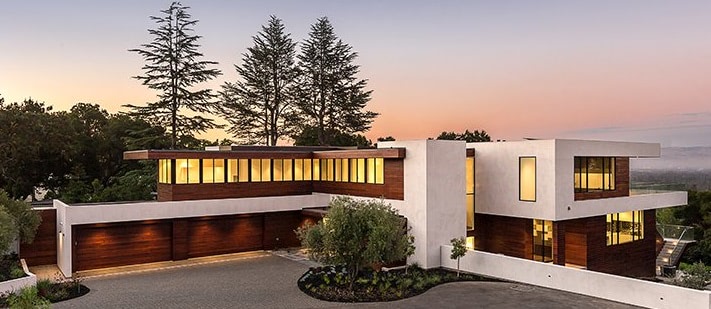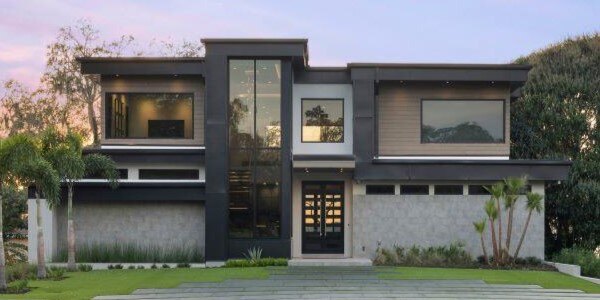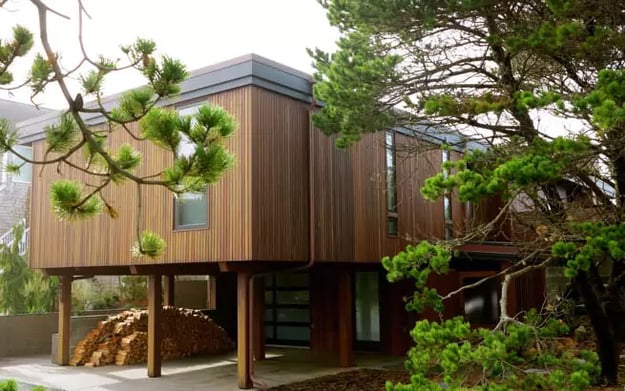
Explore The Best Rainscreen System for Labor Saving Installations
Written by Liza Sivek onChoosing the best siding for home construction is a critical decision for architects, designers, builders, installers, and homeowners. While many siding types are available, few offer the long-term protection and performance of a rainscreen system. From the outside, many rainscreens look alike, but their performance varies significantly based on what's happening behind the siding. Let's explore the different types of rainscreen systems and why they matter for your project.
 Ipe wood vertical siding using the Climate-Shield rainscreen system on a modern barn-inspired home
Ipe wood vertical siding using the Climate-Shield rainscreen system on a modern barn-inspired home
A rainscreen is an advanced design and installation method that allows siding to stand off the exterior wall, creating a ventilated air space that helps your building breathe better. This simple yet effective concept is an essential component for minimizing moisture buildup, preventing mold, and extending the life of your siding.
Understanding Rainscreen Systems: Closed Joint vs. Open Joint
A properly designed rainscreen system works by creating a wall cavity behind the siding, which provides a pathway for moisture to escape. Without this back ventilation, wood siding can trap moisture, leading to rot and peeling paint.
Closed Joint Rainscreen Systems
Closed joint rainscreens are the most basic option. They typically use wood furring strips to create a small air space between the siding and the building envelope. This system only ventilates at the top and bottom of each wall cavity channel.
While it's better than not having a rainscreen at all, this limited ventilation can cause problems:
-
Limited Moisture Escape: The furring strips themselves can block moisture from escaping and can even retain moisture, potentially leading to mold and rot.
-
Vulnerability to Debris: The top and bottom vents can easily become blocked by leaves, snow, or other debris, which stops ventilation. Make sure they stay clear for proper ventilation.
-
Shorter Lifespan: This system is often a lower-cost option upfront but may have a much higher h long-term maintenance cost.
-
Common siding types used with this system include clapboard, shiplap, tongue and groove.

Want to see Mataverde Rainscreen Siding and Clip for yourself? Request a sample here.
Open Joint, Back Ventilated Rainscreen Systems
Open joint rainscreens offer superior performance by allowing for more air movement and drainage. To work properly and extended the lifetime, it is imperative to properly weatherproof the building envelope behind the siding before you start.
Open Joint with Furring Strips
This method is an improvement over the closed joint system. It uses special rainscreen clip hardware to create small gaps between each row of siding, allowing for more convective air flow within the wall cavity.
While it performs better, it still shares the limitations of using wood furring strips. The anticipated life expectancy for a properly installed open joint, back ventilated rainscreen system is usually around 15 years or more.
Open Joint with No Furring Strips (The Best Option)
This is the most effective and high-performance rainscreen method. It's often referred to as a "pressure equalized" rainscreen because there are no furring strips to impede air movement. A high-performance system like Mataverde Climate-Shield uses patented clip hardware that eliminates the need for furring strips. This provides several key benefits:
-
Maximum Airflow: The unobstructed wall cavity dries much faster than other systems.
-
Easier Installation: Without the need for furring strips, installation is often easier and can save on labor costs.
-
Superior Durability: This method can last 25 years or much longer, making it the top choice for builders and luxury homeowners who prioritize longevity and low maintenance.
 Climate-Shield Wood Rainscreen vertical siding using Garapa hardwood
Climate-Shield Wood Rainscreen vertical siding using Garapa hardwood
Watch this quick demo video now to see the difference in three types of siding using a rainscreen system:
Ready to see how it works for yourself? Ask for a wood rainscreen siding and clip sample now!
 FSC Machiche wood rainscreen siding was used on the entire facade of this custom home, contrasted with cement
FSC Machiche wood rainscreen siding was used on the entire facade of this custom home, contrasted with cement
Why a Rainscreen System is the Best Siding for Home Performance
Rainscreen technology has been used for centuries, but it's becoming increasingly popular in modern US residential construction. For homeowners who value a healthy, comfortable, and energy-efficient home, a rainscreen system is an excellent investment.
The Benefits of the Rainscreen Wall Cavity
The wall cavity created by a properly designed and installed rainscreen system provides multiple functions that protect your home:
-
Drainage: Any moisture that gets behind the siding from rain or sleet can drain directly out the bottom of the wall cavity. Without this space, moisture becomes trapped, creating ideal conditions for mold and decay.
-
Moisture Escape: Moisture from inside the house can escape through the wall cavity. This is particularly important for modern, tightly constructed homes where trapped moisture can be a significant issue.
-
Prevents Mold and Decay: By allowing moisture to drain and ventilate, a rainscreen minimizes the conditions that lead to mold, mildew, and rot, which can cause structural damage and unhealthy living situations.
Beauty and Durability in One Package
When choosing the best siding for home projects, you don't have to sacrifice beauty for functionality. Many beautiful, long-lasting natural wood species are perfect for rainscreen systems, including Ipe, Garapa, FSC Machiche, Jatoba and thermally modified Hemlock.
These natural woods are not only stunning but also well known for their durability and performance, making them an ideal choice for building a "100-year-old home."

Climate-Shield Wood Rainscreen Siding Moisture Management Diagram |

Climate-Shield Passive Layer Diagram - A Natural Energy Solution |
 Mataverde Climate-Shield wood rainscreen vertical siding and wood covered soffit
Mataverde Climate-Shield wood rainscreen vertical siding and wood covered soffit
Want to know what the price for your project will be? Ask us for a complimentary quote here.
While a rainscreen system may not be right for every project, it is a time-proven option for builders and owners who want a beautiful, high-performing, and durable home. For savvy professionals and discerning clients, investing in a high-quality rainscreen system is an investment in the long-term health and value of the home.
What kind of rainscreen system are you considering for your next project? Contact us now with questions or for more information.

Related Posts





